Chairman’s Comments
Sadly since our last UTL we have lost Ken Smallwood who was a founder member of this branch. Ken was laid to rest at Southern Cemetery, Chorlton, Manchester on 23rd October. There was a very good turnout of members of the branch who turned up to represent us all and pay their respects. Andy McVeety has provided us with a short obituary and we say goodbye to a very nice man who was determined to remember and acknowledge the sacrifice, of especially local men, in the Great War. On Ken’s behalf I mention his friends of that time, and we remember veterans George Ashurst, Albert Birtwistle, Bill Dutton, Joe Fitzpatrick, George Franklin, Reg Glenn, Tom Haddock, Charles Heaton, Albert Hurst and Bill Smedley. All were branch members well known by Ken and attended meetings in the early days of the branch.4
There are also talks available via the WFA YouTube channel and weekly webinars. Investigation of the WFA website will lead you to a wide selection of articles as well as films available through your membership, plus the ever-growing list of podcasts now available.
Remember you can still get your history fix by attending the national WFA online Zoom lectures and also the new Webinars lectures, plus the WFA’s YouTube channel. It would help if you subscribe to their channel too, which you can do on the page. It’s absolutely free, but having a lot of subscribers does give some additional benefits and means that you will be notified whenever a new video is uploaded. www. westernfrontassociation.com
h t t p s : / / w w w. y o u t u b e . c o m / c h a n n e l / UCBsj9MPDJLLSIlR-LI2Uq9g?
Our disappointment in the cessation of our meetings continues. Our lives have been turned upside-down in these strange times. We must dig in and be resolute. Looking back to the WW2 generation there are enough examples of hardship and the unforgettable blitz of course. The Spanish flu pandemic 1919/1920 was terrible but the country came through it.
We’ll continue with our interest in the Great War, amongst our many other interests and pursuits, and return to normal, eventually.
Ralph Lomas
*We are unable to hold our usual commemoration service but I’m sure we will all be thinking of those that died and those that survived the Great War at the appropriate time.
Zoom meeting 13 Nov, 2020 7:45 pm Speaker: Rob Thompson
‘Gas Boys! Gas! The Battles of Second Ypres and the Making of the Third’.
This talk examines Second Ypres, infamous for the use of German chlorine gas. Yet it was not the gas that caused the horrendous casualties suffered by the BEF but the more ‘common’ technologies of rifle, machine-gun and artillery. This battle also marked the furthest advance of Germany in this vital area until 1918. This German attack shaped both British strategic thinking and Haig’s focus on Ypres and ultimately what would become the infamous Third Battles of Ypres.
To join Zoom Meeting: click here
or log in to Zoom and use the following details
Meeting ID: 830 0481 1139 Passcode: 354311
Obituary
Ken Smallwood 1932 – 2020
Ken was an early member of the Western Front Association and was approached by WFA founder, John Giles, to form a local branch in the Manchester area. Ken was far too modest a man to put himself forward but he did make contact with other members of the WFA in the locality and through his efforts a branch was born! Ken knew and had many in depth conversations with surviving WW1 veterans including Paddy Kennedy and George Ashurst, whose book may well not have been published without Ken. He told me of an early branch meeting where a speaker on the 1918 German offensive was constantly being interrupted by an old gentleman. When challenged the heckler said that is not how he remembered it! Ken was also responsible for raising the funds for the plaque to the Manchester Pals at Heaton Park. Ken was a true Gentleman and never had a bad word to say about anyone, but more than that he was a true friend. I will miss Ken terribly and trips to and from the WFA meetings will never be the same for me. Andy McVeety
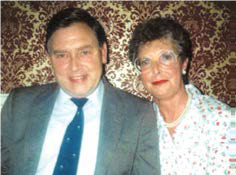 Also, Clive Harris of Battle Honours Ltd has emailed John Richardson to say: Ken was a real star and I hope he is now re-united with both his beloved Ada and Paddy Kennedy. I feel privileged to have known him well enough to call him a friend and will treasure both the memories I have of Ken and the letters he wrote.
Also, Clive Harris of Battle Honours Ltd has emailed John Richardson to say: Ken was a real star and I hope he is now re-united with both his beloved Ada and Paddy Kennedy. I feel privileged to have known him well enough to call him a friend and will treasure both the memories I have of Ken and the letters he wrote.
The Pals Plaque at Heaton Park – a chance remark!
Ken Smallwood
Reprinted from the Bulletin number 105, August 2016
One Sunday in November 1989, I was with Cliff Blood and Alan Pawson in Heaton Park. They had kindly agreed to show me around the four camp sites used by the Manchester Pals in 1914-15. “It’d be nice if there was a plaque that stated that the Pals trained here” remarked Alan. A chance remark, but why not, I pondered.
The following day, I wrote to the Planning Office at Manchester City Council. Their reply was: ‘we no longer have a budget for plaques but approve the principle of a plaque to the Pals’. Correspondence continued to and fro for many months. Then in June 1991, the Council reiterated the problem of funding stating that, if I was able to obtain funding, they would be happy to arrange procedures for the plaque. This I was more than happy to do.
I then enthusiastically submitted an appeal for donations to the Manchester Evening News Postbag. The response was immediate, contributions, large and small, with many letters of support. Eventually £401-04 was raised. There were, in all, seventy-four kind-hearted contributors, plus the resulting Building Society interest. There was £10 from Anonymous, Manchester “In Memory of the Manchester Pals - We will Remember Them” a generous £50 from Mr & Mrs Thomson of Frodsham; Martin Middlebrook sent a contribution. Many subscribers remembered, and named, relatives who had served, and in some cases died, with the Manchesters.
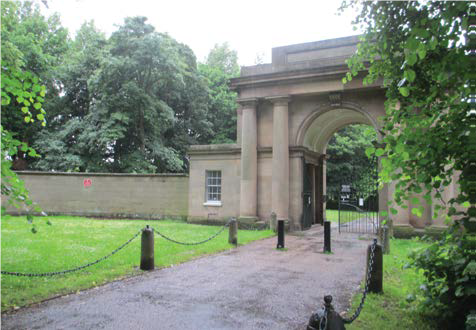 Correspondence regarding one thing and another continued to August 1992. Then with the historical guidance of Captain Bob Bonner of The Museum of the Manchesters, a suitable inscription for the plaque was decided upon. I had asked for the Western Front Association to be included on the plaque but the Council did not permit sponsors names. This I didn’t consider a problem since a high percentage of the contributors were outside the WFA. So, the plaque was made, red in colour, by Broxap & Corby of Radcliffe, for the sum of £200-01. And in February 1993, for a further £35, they expertly fixed the plaque to the wall adjoining the Sheepfoot Lane entrance to Heaton Park.
Correspondence regarding one thing and another continued to August 1992. Then with the historical guidance of Captain Bob Bonner of The Museum of the Manchesters, a suitable inscription for the plaque was decided upon. I had asked for the Western Front Association to be included on the plaque but the Council did not permit sponsors names. This I didn’t consider a problem since a high percentage of the contributors were outside the WFA. So, the plaque was made, red in colour, by Broxap & Corby of Radcliffe, for the sum of £200-01. And in February 1993, for a further £35, they expertly fixed the plaque to the wall adjoining the Sheepfoot Lane entrance to Heaton Park.
On Tuesday 7th of September 1993, at 11am., an official unveiling ceremony was held. A considerate introductory address by Captain Bob Bonner, ushered a fine speech by Lt.Col. M.C. Parish MBE 5/8 Kings Regiment TA, who in turn, performed the unveiling.
We were honoured to have three veterans there. Albert Hurst, probably the last survivor of the 17th Pals; Joe Fitzpatrick, 2/6 Manchesters and branch member plus Albert Birtwistle, 1/5 East Lancs., also a branch member. Also represented was Broughton House. Interestingly, the unveiling took place the same week that the Pals first marched into Heaton Park, 79 years before.
The Manchester Evening News was amply informed of the ceremony, but disappointingly failed to turn up. They did however, publish a scant report a while later. The Prestwich & Whitefield Guide published a splendid two-page spread in March 1993, featuring Alan, Cliff and myself, and a storyline on that chance remark.
After completing payment for the plaque, there was a balance of £166-03. I decided to distribute as follows: £70-03 Broughton House; £56-00 The Museum of the Manchesters; £40-00 The Pals Plaque at Montauban.
Today, Cliff, who lives close by Heaton Park, keeps an eye on the Pals plaque, and like all of us, remembers.
News of the Pals plaque inspired The Aircrew Association to want to do likewise for the 133,516 aircrew cadets stationed at Heaton Park in World War Two. I was asked to assist, and was pleased to do so. I was flattered to receive a warm invitation to join their VIP party for the plaque ceremony and lunch at Heaton Hall, September 1995. The Aircrews plaque, which is sky blue, is sited within the park, near the hall, if memory serves me right. Also in 1995, I wrote to Morecambe Council, regarding the feasibility of a plaque to honour the 20th 21st 22nd and 23rd battalions of the Manchester Pals who were based in the town for training. Their reply was: ‘a chief difficulty, identifying a site for a plaque’; an opinion repeated by the KORR Museum in Lancaster. Also, there was, understandably, no particular historical association with Morecambe. Tom Brophy and Michael Stedman gave me their support, but in the end, the matter was shelved.
Private Memorial tells a local soldier’s story
20th Manchesters attack at Bois Francais, nr Fricourt, on 1st July, 1916
Eric Hunter
In the graveyard of Christ Church, Woodford, Stockport there lies a large ornate wooden cross, rotten with age, broken, and placed over its original footing. Upon the cross the epitaph reads:
“In Loving memory to Sec Lieut Frank S. Brooks. 20 Manchester Reg (Pals) Killed in Action at Fricourt France. July 1st 1916. For King and Country.”
Frank Smith Brooks was born in 1897. His father Arthur was a successful solicitor with offices in Manchester and Stockport. The family lived in Gatley when Frank enrolled at Manchester University to read Law with an ambition to be involved eventually within his father’s business. Frank, prior to completing his studies, enlisted in the Special Reserve and became a Private in the North Staffordshire Regiment. He was mobilised at the outbreak of war but in November 1914 he applied for a Commission and was posted to 20 Manchesters (5th Pals).
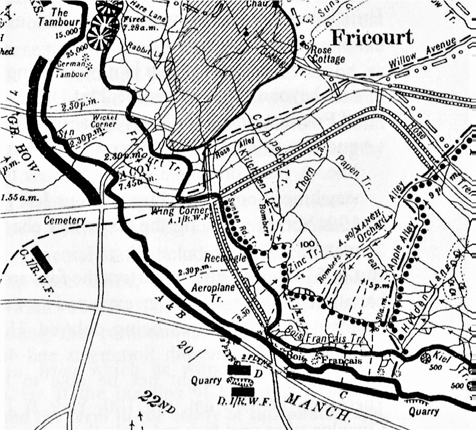 On the First of July 1916 the 5th Manchesters attacked at 14.30 on a front opposite Bois Francais. The division between the front lines varied between 80 – 220 yards. The attack was brief and by 14.45 the German front trench was taken. Frank, his Commanding Officer and over three hundred of the regiment fallen, injured or missing. The successful attack by the Manchesters at Fricourt meant that the bodies of the fallen could be buried and recorded in a dignified manner. Lieutenant Brooks and his comrades were initially laid to rest in the captured German trench. After the war Frank’s body was exhumed from the wartime burial and interned in Dantzig Alley British War Cemetery.
On the First of July 1916 the 5th Manchesters attacked at 14.30 on a front opposite Bois Francais. The division between the front lines varied between 80 – 220 yards. The attack was brief and by 14.45 the German front trench was taken. Frank, his Commanding Officer and over three hundred of the regiment fallen, injured or missing. The successful attack by the Manchesters at Fricourt meant that the bodies of the fallen could be buried and recorded in a dignified manner. Lieutenant Brooks and his comrades were initially laid to rest in the captured German trench. After the war Frank’s body was exhumed from the wartime burial and interned in Dantzig Alley British War Cemetery.
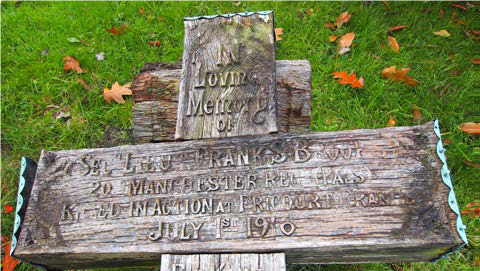 At some point during or after the war the family moved to nearby Bramhall Lane and the Woodford church presumably became their place of worship. So Frank is not buried in Woodford, neither is his name included on the War memorial within the church.
At some point during or after the war the family moved to nearby Bramhall Lane and the Woodford church presumably became their place of worship. So Frank is not buried in Woodford, neither is his name included on the War memorial within the church.
The family had this memorial made and erected in their local church as an act of very personal remembrance.
Further down the cross there is another inscription;
“also of Cyril infant child of Edith and Arthur Brooks.”
This was a very personal act of remembrance, one which was probably evoked each week as they attended worship. Their loss was not just their sons but it appeared their future.
My initial feelings when I first discovered this rotten fallen cross was, as a Great War enthusiast, a memorial in a tragic state of repair. When I reflect however I begin to appreciate that memorials have multiple significances. If the Brooks had wanted a memorial to last forever, they would have commissioned it from stone not wood. It was a very personal statement for the lives lost, over which they had no control.
I have not researched if there are still members of the Brooks family that live locally and perhaps keep Frank and Cyril’s memory alive. We in the WFA remember but not in the emotional context, for which this memorial was erected. To that end is intervening and restoring or replacing the cross an appropriate response, or should we just acknowledge and note its existence and let time ultimately reduce any personal attachment?
Footnote: We also have at our branch a member, Paul Fitzgerald, whose grandfather was also with 20 Manchesters on that famous day on the opening of the Somme
WW1 Soldiers’ Poignant Messages surviving near Llangollen
Peter Dickinson
Berwyn railway station stands prominently alongside the A5 road just over a mile east of Llangollen in North East Wales. It was built to primarily serve the needs of the landed gentry who had established large estates in the vicinity. The station opened in 1865 as an intermediate stop on the Llangollen & Corwen Railway, which ultimately became part of the Great Western Railway’s cross-country route linking Ruabon and Barmouth. As space was at such a premium in the area, the station was built on a rock ledge cut into the southern side of a narrow gorge, overlooking the tumbling waters of the River Dee.
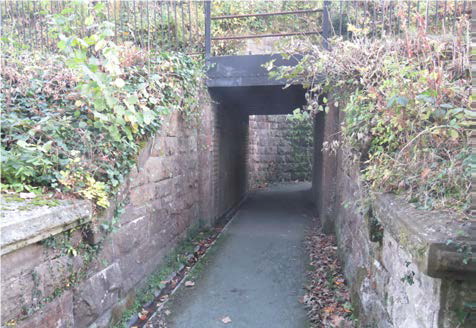 Whilst the station itself has a fascinating history in its own right and has since been preserved as part of the Llangollen Railway, it is not the main focus of this article. For just metres away from the station’s platform can be found a series of poignant messages written by soldiers from the First World War. This is the story behind just some of these men, the structure they are on and the efforts being made now to conserve them.
Whilst the station itself has a fascinating history in its own right and has since been preserved as part of the Llangollen Railway, it is not the main focus of this article. For just metres away from the station’s platform can be found a series of poignant messages written by soldiers from the First World War. This is the story behind just some of these men, the structure they are on and the efforts being made now to conserve them.
From its opening until at least the mid-1890s, the station was connected by an access path to the Chain Bridge over the River Dee. This path crossed over the railway line at the eastern end of the platform and this became the scene for a fatal accident just a few days before Christmas in 1896.
On Tuesday 22nd December Charles Roberts, a Blacksmith and his wife Jane had been visiting friends near the station. Shortly after 9pm they were on their way home and as they approached the ungated crossing heard a train approaching them. Assuming this was the mail train that was due to stop at Berwyn they continued across the track. Unfortunately it was a ‘special’ put on to cope with the increased amounts of mail being carried in the run up to the festive period. The crank of the steam locomotive caught the side of Jane Robert’s head and her body was found about fifteen yards from the crossing. Charles Roberts sued the Great Western Railway and received substantial damages.
The fatality and the increasing popularity of the walking route led to the Great Western Railway deciding to remove the crossing completely and replace it with a pedestrian underpass. A steep pathway was excavated adjacent to the railway, almost as a continuation of the platform ramp, leading to a short 6-foot wide tunnel under the one railway track. The structure in itself may have been fairly unremarkable, but for the fact that it was finished in white glazed bricks. The bricks seemed to have taken pencil markings readily, especially from the indelible type issued to soldiers during the First World War. Teenage conscripts used their pencils to write notes on the subway’s walls and many of these still survive today, albeit becoming increasingly at risk from water ingress and deterioration.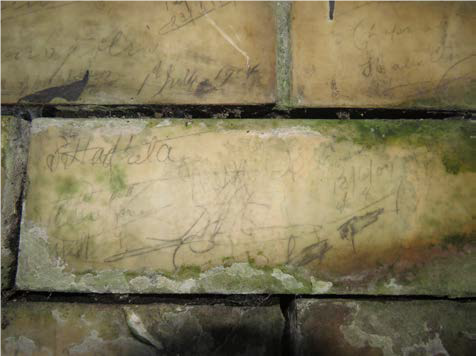
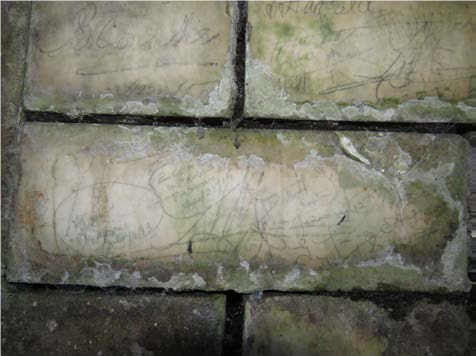
One entry on the walls shows that E. M. Morris and R. Roberts shared a cigarette together there on 6th July 1913. By the time they returned on Christmas Day the following year, they had both enlisted in the Army and had quickly been promoted. Indeed R. Roberts signed his festive message with the ranking of a Lance Corporal. Some of the other scribblings indicated soldiers in light-hearted mood, including ‘Balls from Belgium’, ‘Berlin Last Stop’ and ‘Hoof Hearted’. Over subsequent years, the walls of the subway continued to attract more notes and messages in pencil up until at least the 1960s when the railway closed. In our modern society, graffiti is often seen as defacement and vandalism in most situations. Yet after the passage of a century, the written WW1 messages on the subway walls have become poignant and important historical artefacts in their own right.
Despite the closure of the railway through Berwyn in 1965 and the subsequent removal of the railway track by 1968, the structure of the subway was retained. However this resulted in neglect and structural failures led to water ingress and deterioration of the pencil messages commencing. The rebuilding of the line as part of the preserved Llangollen Railway and the subsequent piecemeal maintenance being afforded to the subway has reduced this deterioration somewhat.
However, in the 1990s, the increasingly dilapidated condition of the nearby Chain Bridge resulted in its closure to the public. The connecting footpath from the station and associated subway were no longer part of a thoroughfare and began to deteriorate further. During the mid-2000s the pencil messages were first spotted by David Gepp, a lecturer in photography at the Herefordshire College of Art. He recalled that ‘a friend said that there was a tunnel where soldiers used to hang around and have a fag. My wife and I went there and came across the name Alfred James Candy written on the wall of the tunnel. As we were going home I noticed a war memorial and pulled over to have a look. On the second line, there he was, Alfred James Candy’.
David Gepp’s discovery led to him arranging a temporary exhibition on the signatures in Llangollen’s Museum in 2007. This attracted considerable interest from the local media and the public, but unfortunately did not lead to any conservation work on the subway itself. It was in their deteriorating and forlorn condition that I first came across the signatures whilst undertaking geology fieldwork in the area in 2011. The following year I became a volunteer at Berwyn station and commenced a programme of regular vegetation clearance around the subway. The nearby Chain Bridge reopened to the public amid much celebration in 2015 due to the sterling efforts of the local councils and the Heritage Lottery Fund. The restoration work on what is thought to be the oldest chain bridge in the world, also included resurfacing and restoration of the connecting path up to Berwyn station.
The increased footfall from visitors once again put the subway and pencil messages back into the public limelight. Efforts were made to increase public awareness through free information packs and temporary displays at the station, including the display of commemorative wreaths and even a GWR WW1 stretcher. A major boost came over this past summer, when BBC Wales ran an article online about their significance and fears that they were being lost to the damp. Indeed, water ingress has continued to deteriorate and engulf the pencil messages; with the central parts of the walls now almost entirely covered by algae. Given the wider commemorations taking place and the increasing numbers of visitors passing through the subway, the media coverage has this time led to a concerted effort to ensure it is conserved and restored as sympathetically as possible. With the blessing of the Llangollen Railway, I have been leading the conservation project and have been working closely with the Llangollen Museum, Denbighshire County Council and many other local stakeholders. Yet it is not as simple as just cleaning off the brick faces with soapy water – far from it! One of the first stages is to tackle the problem of the water ingress in and around the structure. Groundwater confined within the natural mudstone bedrock in the area naturally seeps out of the retaining walls on the approach to the subway, whilst further east it passes at depth under the railway trackbed. Rainwater also passes down through the stone ballast that supports the railway track over the subway. Over time, small-scale deterioration of the brickwork and metalwork has led to this water working its way through the structure and running down the white glazed bricks, leading to the build-up of algae over the pencil messages.
Drainage improvements will be required to capture the water from around the subway and deflect it away; either along the sides of the track or through pipe under the railway itself. A new waterproof membrane is likely to be required over the subway to stop rainwater passing through the ballast and getting into the structure. This will require the lifting of the railway track and ballast from above the structure, which can only be carried out at a time when the Llangollen Railway’s heritage steam and diesel trains are not running, i.e. in either November, January and/or early February. Once improvements to the drainage and structure are carried out, the then work can start in earnest in recording and conserving the signatures on the subway walls. Methods of cleaning off the algae are currently being explored with specialist conservators and a number of Welsh universities. This will hopefully uncover many more signatures and poignant messages hidden on currently obscured parts of the glazed walls. Volunteers at the Llangollen Museum have already begun researching some of the messages that are still visible on the subway’s walls. One of these is the message by AJ Candy spotted by David Gepp over a decade ago, which reads “I really want --is baby”. Research into Candy’s life and military career has revealed that he is incorrectly listed on the Llangollen war memorial and was actually named Albert rather than Alfred.
It transpires that Albert James Candy was born in Cardiff in July 1887. His father died when Albert was only three and tragically his mother died in May 1895. Albert and his older brother Frederick were soon admitted into an orphanage in Somerset, where the trail temporarily goes cold. However, by 1911, he had found work at a bakers and confectioners’ shop in Llangollen.
There is currently no record of when he joined up, but from the Commonwealth War Graves we have found that on 17th April 1917 James Candy 675653, Royal Field Artillery, “D” Battery, 285 Brigade was killed. He was buried at plot 4, Row D, Grave 14 in Le Grand Hasard Military Cemetery, in Morbecque, Northern France.
Further research is ongoing into the other names presently uncovered on the subway walls including E M Morris and R Roberts. It is hoped that as the project progresses we can discover more about the soldiers and locals who used the walls of the structure to record their messages and stories. Any further information or assistance in researching the messages would be gratefully appreciated by myself and the other volunteers actively involved this project.
About the Author Peter Dickinson is an active volunteer on the Llangollen Railway and his first book on the line, ‘Steam in the Dee Valley – From Ruabon to Corwen via Llangollen’ was published in 2015 to coincide with the 150th anniversary of the railway opening. His latest book is ‘The Ruabon to Barmouth Line’ by Fonthill Media (ISBN: 978-1-78155-214-8). Peter has given talks at the Llangollen Museum ‘Rails to the British Tyrol’, focussing on the history of the Llangollen & Corwen Railway and featuring the graffiti.
